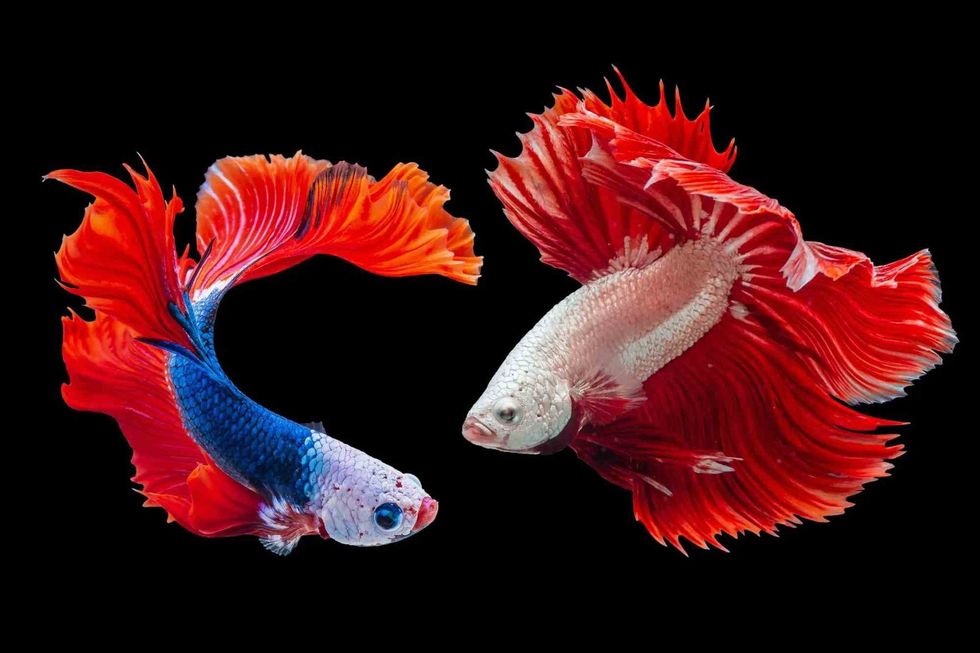Fin rot disease is quite serious, and one which an aquarist needs to be aware of when taking care of an aquarium as it will wreak havoc on any affected tank.
There are many fish owners or aquarists who do not know much about this disease. Eventually, they will get to know when their fish is affected by this disease.
Here are few detailed tips on how to treat fin rot.
There are five basic steps to do so and the first one is that the infected fish must be quarantined.
The foremost thing to consider is to remove the fish which are infected from the tank community, as fin rot is not a common disease, but a contagious one.
By carrying out this activity, you will be able to cure diseased fish more effectively, and this prevention method will not damage other fish in the communal tank.
To cure the infected fish set up a normal-sized quarantine tank and ensure the water temperatures and quality as the fish should not be harmed because of the change in water parameters and the last thing in this stage you need to do is cause damage to the fish's fins.
The second step is analyzing aquarium water quality, you need to check the water parameters to prevent fin rot, and when you see that there is a condition when the fish is out of danger try to figure out that why the disease took place and therefore the first thing to look at is water conditions in which the fish was kept earlier.
You can buy testing kits for water from the nearest pet stores as these kits are useful in checking the level of ph and other contaminants, a thermometer can also be used to do the same (checking the water temperature) and the test results should provide you a lot more details and information regarding the amount of nitrate and ammonia levels.
The next step should include well cleaning of the community tank or aquarium and make changes that are necessary for the fish.
As we people like to live in a surrounding with proper hygiene, in the same way, the fish also deserves the same so their fish tank should also be deep cleaned and no matter cleaning or tidying the aquarium may not prevent the fin rot but it will prevent fin rot from happening again and also prevent it from the bacteria.
Make sure you remove decayed plant matter or old nasty food remains, and then make use of a vacuum (substrate) to remove any kind of waste left in the fish tank.
To remove all the bacterial infections left in the tank because of the bad shape of the tank or even the bad environment, this helps you in removing all the grime from the entire surface of the tank and all the bacteria.
For many more interesting fun facts, you can also check how to get rid of skunks and how to get rid of sugar ants.
What is fin rot?
Fin rot, generally, is defined as a disease inherited by a fish.
This kind of disease is more often observed in places like aquaria, aquaculture, and even in natural populations in the sea.
Fin rot is generally caused by a bacterial infection (Pseudomonas fluorescents) which is known as a ragged rotting of a fish's fins.
It can also be identified as a fungal infection in an aquarium fish which causes rotting on the fin and produces a white edge.
This disease is caused by various factors like poor aquarium water conditions, injury, poor diet, stress, and sometimes even both the infections are seen and it may also be caused in a fish which is already stressed by some other disease.
Fin rot starts from the edge and it destroys all the tissue until it reaches the fin base and if this stage hits the fish then there is no going back to regenerate the lost tissues from the fish's body and this is known as advanced fin rot and body rot.
This disease is common among betta fish (Siamese fighting fish) due to the water quality being poor, which are available at pet stores.
There are several prevention and treatments which are used to cure and make less the spread of this kind of fish disease.
Fin rot disease can be prevented with good water quality, fish should be provided with fresh food in freshwater and this should be in constant water temperature and the food provided should be in small proportions.
The tank in which the fish is kept should be prevented from becoming cluttered.
This will help in treating fin rot.
There are a number of treatments that help in treating fin rot and these are changing the water and checking the filter, antibiotics should be used to treat rooting if it is jagged, figure out the ph of the water and correct it if necessary so that you can treat the fin rot using a proper treatment like phenoxyethanol or other proprietary agents.
Aquarium salt for fin rot is a type of good treatment hence make sure that all the products used should be in fresh water and not saltwater neither in fish water.
Water temperature should be set at 75.2-78.8 ℉ (24-26 ℃).
It is referred that antifungal medication should be used if the fin rot spreads over and the fin has holes as it can also be signs of some other external columnaris infection which may lead to fin rot or if it spreads rapidly within 24 hours and the rotted edge appears with a white and fuzzy look.
Some signs which show that a fish is suffering from fin rot and these signs are when the color of fin edges changes to black or brown, fins fray, the fins base gets inflamed, entire fin rot or fall off in large chunks when the fins show white dots on the body it is a symptom of Ichthyophthirius multifiliis.
Fin fraying is seen on betta fish which can also be treated by checking the filter.
Ways To Treat Fin Rot
There are several ways to treat fin rot if your pet fish has been troubled or infected by it.
If you see any symptoms, it is treatable.
Fin rot, generally caused by some bacteria which can be treated by adding medications, including Aquarisol and Melafix in their aquarium water because the best treatment for fin rot consists of killing the bacteria present in the aquarium or tank.
Medications like the use of Melafix can be used for killing bacteria and there are no side effects of the same and it gains success at a high rate and it should be known by every aquarium owner in case of need.
If a goldfish is kept in the aquarium take proper care of it and keep it healthy by looking into the health measures and safety for them.
But an aquarium owner should know that all kinds of medications are not safe for the fishes like Oxytetracycline, Tetracycline, methylene blue malachite green and Chloramphenicol have been used as drugs or we can say medicines but they may sometimes affect the health of the fish by showing side effects.
Fish filter water with the help of their gills which clearly indicates that they ingest some things that are not healthy for them.
It is known that fin rot has been caused by fungal infections and the symptoms are clearly seen first on the fin's edges, and tail and if holes are also seen then it is a clear indication of the fungal infection.
To treat fin rot in the fish species first of all check their environment because it happens in many cases that there may be some environment-related factors that can cause stress to your fish and after you figure the cause that leads to fin rot remove that stress so your fish can start recovering.
Clean the fish tank with a proper interval of durations because the water is sometimes affected by the medication you give to your fish to cure fin rot, treating fin rot through medications is very common and the most important is to make your fish very comfortable.
Sometimes, the medication affects the water in such a way that it becomes very hard and the fish feels difficulty in breathing, so you should add on a sponge filter or air stone to maintain the water oxygen level.
The last way you can treat fin rot is using aquarium salt if any kind of medication is not available at the pet store.
How long does fin rot take to heal?

Fin rot, a kind of disease that is not only common among betta fish but also other species of fish. The recovery time of any disease is based on how serious the problem is.
The same applies to fin rot disease.
You must know how severe the problem is, then only it can be determined how much time it would take to heal.
But, as a rough estimate, we can say that it takes around four to five days or a week to recover from fin rot. The water in which the fish is kept should be clean and the compatibility should be checked before adding new fish to a tank to prevent fin rot or nipping or even fighting.
The water quality should be good to prevent fin rot and should be changed weekly, and for better results, you can also add a water conditioner to make it cleaner to give the fish an experience of living in freshwater.
The signs showed by the fish when they are recovered from fin rot caused by the bacterial infection is they are back to normal to their actual appetite, the fins will show different coloration and will feel more alive.
They will be in the same energy found swimming, playing with other fish without any fin nipping, and will remain stress-free.
How to prevent fin rot?
The prevention and treatment for fin rot is done in many ways.
The symptoms can be best prevented by maintaining the pH level of an aquarium.
The water parameters should be checked on a regular basis, vacuum the gravel when feeding the fish provide them food in small portions and in less quantity because then you may sense some symptoms of overeating by the fish can cause some kind of waste in the aquarium or community tank which can cause problem from other fish in the tank.
The nature and compatibility of a fish should be checked before placing them with new fish in a tank or aquarium to prevent fin nipping or any kind of fighting.
They should be fed in little quantity which they may consume in three minutes twice daily.
Overfeeding is the biggest a fish owner makes which contributes and is responsible for the poor quality of water and encourages bacteria so food should be purchased in small packages which can be used for at least one to two months.
Water temperatures should be maintained for those species with long fins as low water temperatures will promote fin rot.
Water in a 1 gal (3.78 l) tank should be replaced every three days whereas a 5 gal (19 l) tank should be replaced every seven days. The aquarium owners should be aware of all the symptoms, prevention, treatment, water parameters, and causes of fin rot.
Anytime you see any sign of sickness in your pet immediately contact your vet as they may check them properly with full history and would recommend proper and right medication for their better health.
Here at Kidadl, we have carefully created lots of interesting family-friendly facts for everyone to enjoy! If you liked our suggestions for how to treat fin rot, then why not take a look at how to take care of fish or Angelfish facts?









